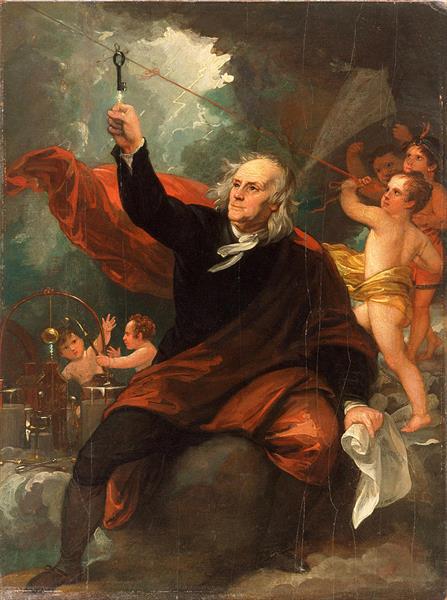Classical Blog Exhibit
Art and Scientific Discovery in the 1700's
With all the topics to choose from, I chose to base this assignment around the theme of Art and Scientific Discovery in the 1700's. I am choosing to go with art that was influenced by the free-thinking people of the 18th century who were influenced by the enlightenment.
Painting 1.
The room is lit up only by one lamp in the middle of the piece which shows that the focus of the painting is the bird, the scientist, and the surrounding audiences faces in contrast with the dark, shadow-filled background. The emotion of this painting, judging by the looks on the faces of the audience, seems to be a mix of sadness, interest, and curiosity. The darkness around the figures draws the observer towards the faces of the subjects. Science is meant to be exciting and fascinating and interesting. Did they know what to expect? Did they know an animal could be harmed?
As for the theme of scientific discovery, this highlights it because of the air pump used in this experiment. The air pump was created by a man named Robert Boyle in 1658 and it was used on animals to deprive them of oxygen to show the importance of air, which was done in the pursuit of knowledge. I find this type of experimentation troubling because animals are innocent creatures whose lives are every bit as important as ours. Can we really say that the ends justified the means here? I don't think so.
PAINTING 2.
The second painting comes from France. It was painted by Jacques-Louis David in 1788 using oil paint on canvas. The portrait depicts Antoine-Laurent de Lavoisier and his wife Marie-Anne Paulze Lavoisier.
Jacques Louis David | Antoine Laurent Lavoisier (1743–1794) and Marie Anne Lavoisier (Marie Anne Pierrette Paulze, 1758–1836) | The Metropolitan Museum of ArtAntoine-Laurent de Lavoisier (a.k.a. Antoine Lavoisier), was a French nobleman and chemist, known for naming oxygen in 1778 and recognizing it as an element. Five years later, in 1783, he also recognized hydrogen as an element. He made many other important scientific discoveries and predictions, including helping create the metric system. His wife, Marie-Anne Paulze Lavoisier, also pictured in this painting, was a chemist in her own right.
The softness of the subjects is so lifelike, almost photographic in nature. The tablecloth fabric looks velvety yet strong. Madame Lavoisier's dress and hair are perfectly textured as well. Scientific equipment sits on the table with sheets of paper under Monsieur Lavoisier's hand and quill. The way she is standing over him makes it look like they are discussing what to write, and their discoveries together. She was every bit his equal in science and her pose makes it clear she is as important as he is. This type of portrayal of a couple during this time would not be typical, since many women were below their husbands in status. More scientific objects are resting on the floor by the table. The glass gasometer on the table is beautifully painted as well. I feel like I could reach out and touch the glass.



"An Experiment on a Bird in the Air Pump" is such an amazingly detailed painting. I love the way it tells a story while also looking almost exactly like a photograph. I'm guessing by the year that it leans more towards the Rococo side of the Classical era but it feels like it came out of the Baroque era in style. In context of course it must have come out in the classical era as that was when art began reflecting the enlightenment that people were experiencing at the time. The painting of Benjamin Franklin clearly shows a style of Neoclassical and is truly inspiring to look at.
ReplyDeleteI love your analysis, as well as all the scientific facts you noticed. You did a great job noting all the scientific links and machinery, I think at most I would've loved an identification of what machine was sitting next to Benjamin Franklin. Speaking of which, I believe that's my favorite piece you shared! Something about the dark, moody clouds of the rainstorm behind him but the amount of form in the center of the piece is incredibly striking. It almost adds to this feeling of triumph that radiates from the image, with the angels and their hands raised and even the strong pose that Franklin is depicted in. It's a strong image. I'm also especially attracted to the painting depicting Antoine and his wife. I find the implication of their partnership not only in marriage and science is revolutionary, and serves as a strong commentary on husbands and wives. I find the image revolutionary for its time! A wonderful addition.
ReplyDeleteOverall, a wonderful blog post. You did great!
I enjoyed reading your analysis on the three different paintings that highlight the scientific discoveries that were coming about during the classical era. I also did my post on the discoveries of the time, but I focused more towards architecture and how the discovery of Pompei influenced the arts. It was enjoyable to read something about the same topic from an entirely different perspective! One thing that stood out about your post was the first painting "An Experiment on a Bird in an Air Pump". This piece looked so realistic to me in comparison to the other pieces we've examined so far. It looks almost like a photograph.
ReplyDelete